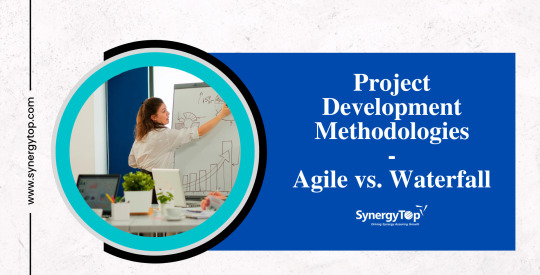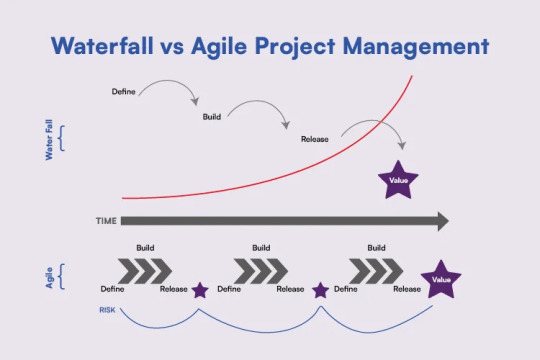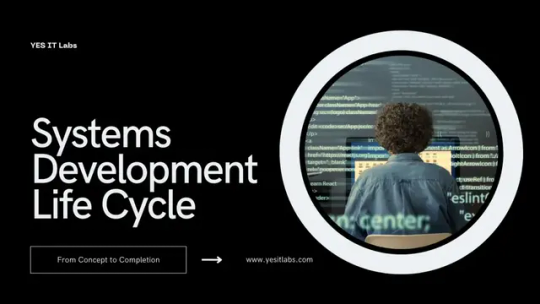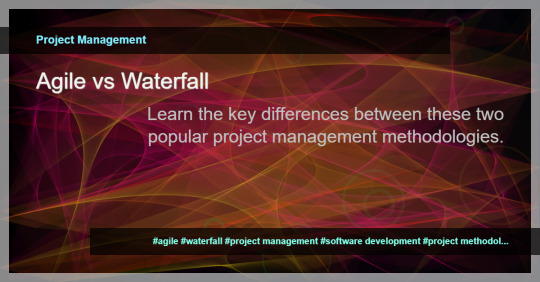#Waterfall and Agile methodologies
Explore tagged Tumblr posts
Text
Project Development Methodologies – Agile Vs. Waterfall | SynergyTop

Dive into the world of Project Development Methodologies with our latest blog at SynergyTop! 🚀 Explore the dynamic comparison between Agile and Waterfall approaches, uncovering the pros and cons of each in the realm of project management methodologies. 💡 Gain insights into choosing the right methodology for your projects. 🔄 Stay ahead in the development game with SynergyTop’s expert analysis. Read more at SynergyTop and elevate your project management strategy!
#agile vs waterfall#waterfall vs agile#project management methodologies#agile project management methodology#waterfall project management methodology#agile methodology pros and cons#waterfall and agile methodologies#project management methodologies comparison#pros and cons of waterfall methodology#difference between waterfall and agile methodology#agile project management#waterfall project management#difference between waterfall and agile
0 notes
Text

Agile methodology is a flexible and iterative strategy that allows teams to quickly adjust to changing project needs and deliver high-quality solutions in less time. In software development, agile is frequently utilized.
0 notes
Text
EVALUATING THE IMPACT OF PROJECT MANAGEMENT METHODOLOGIES ON HEALTHCARE IT IMPLEMENTATION
EVALUATING THE IMPACT OF PROJECT MANAGEMENT METHODOLOGIES ON HEALTHCARE IT IMPLEMENTATION 1.1 Introduction The rapid advancement of technology in healthcare has led to an increased focus on the implementation of Healthcare Information Technology (IT) systems, such as electronic health records (EHRs), telemedicine platforms, and patient management systems. However, the success of healthcare IT…
#Agile methodologies#EVALUATING THE IMPACT OF PROJECT MANAGEMENT METHODOLOGIES ON HEALTHCARE IT IMPLEMENTATION#healthcare IT#implementation#Mixed-methods research#PRINCE2#Project Management Methodologies#Project success#Scrum#Stakeholder engagement#Waterfall
0 notes
Text
Human Capital changes during COVID-19 Pandemic. Why software development methodologies shifted from Waterfall to Agile.
Iacob, Andreea Teodora (2024), Human Capital changes during COVID-19 Pandemic. Why software development methodologies shifted from Waterfall to Agile, IT & C, 3:4, pag, Abstract Human capital has encountered many challenges and changes during the COVID-19 Pandemic. This adaptability that we needed to embrace, to face the many challenges of the Pandemic context, has also increased the human…
#agile methodology#COVID-19#human capital#pandemic#social distance#software development#waterfall methodology
0 notes
Text
Project Management Methodologies Compared: Which is Best Waterfall , Agile , Scrum, Kanban, Lean, Six Sigma or PRINCE2
Choosing the best project methodology depends on the nature of your project, team structure, and organizational culture. Waterfall offers a structured approach, while Agile and its subsets like Scrum and Kanban provide flexibility. Lean and Six Sigma focus on efficiency and quality, and PRINCE2 offers a comprehensive, scalable framework. Understanding the strengths and weaknesses of each methodology will help you navigate your projects to success.
#ProjectManagement hashtag#Methodologies hashtag#Agile hashtag#Scrum hashtag#Kanban hashtag#Waterfall hashtag#Lean hashtag#SixSigma hashtag#PRINCE2 hashtag#ProjectPlanning hashtag#ProjectSuccess hashtag#ManagementTechniques hashtag#ProjectEfficiency hashtag#BusinessStrategy hashtag#TeamManagement hashtag#ProjectLifecycle hashtag#WorkflowOptimization
0 notes
Text

Essential of SDLC: A Comprehensive Guide to Fundamentals, Phases, and Methodologies
Unlock the secrets of the Software Development Life Cycle with 'Decoding SDLC,' offering a comprehensive exploration of key fundamentals and methodologies.
#software development#sdlc#fundamentals#phases#agile methodologies#waterfall#development process#project management
0 notes
Text

Discover the Systems Development Life Cycle (SDLC): From Concept to Completion
Explore the journey of the Systems Development Life Cycle from its inception to achieving project success. Acquire insights into the various stages, methodologies, and optimal approaches through this all-inclusive handbook.
#Systems Development Life Cycle (SDLC)#software systems#software applications#Software Development Company#Waterfall model#Agile methodologies
0 notes
Text
Understanding the Difference Between Agile and Waterfall Project Management
Introduction Agile and Waterfall are two popular project management methodologies used in software development and other industries. Both approaches have their own distinct characteristics and are employed in various contexts based on project requirements and team preferences. Waterfall Project Management Waterfall is a sequential and linear methodology in which project tasks are completed in a…

View On WordPress
0 notes
Text
Agile Vs Waterfall Methodology: Which Is the Best for Your Project?
"Choosing the right project methodology is key to success. Delve into the battle of Agile vs. Waterfall methodologies and find out which one aligns best with your project's unique needs. Unlock the power of efficient development and make informed decisions to propel your project forward." https://jumpgrowth.com/agile-vs-waterfall-methodology/
0 notes
Link
Agile Methodology vs. Waterfall vs. Scrum: A Comprehensive Comparison
Software development methodologies play a crucial role in shaping the approach and success of software projects. Among the most widely used methodologies are Agile, Waterfall, and Scrum. Each methodology has its own strengths and weaknesses, and understanding the differences between them is essential for project managers and development teams. In this article, we will provide a comprehensive comparison of Agile, Waterfall, and Scrum methodologies, exploring their key principles, characteristics, and suitability for different project types.
#agile#agile framework#agile methodology#waterfall#waterfall methodology#scrum#web development#web developing company#web developers#ecommerce
0 notes
Text
How-To IT
Topic: Core areas of IT
1. Hardware
• Computers (Desktops, Laptops, Workstations)
• Servers and Data Centers
• Networking Devices (Routers, Switches, Modems)
• Storage Devices (HDDs, SSDs, NAS)
• Peripheral Devices (Printers, Scanners, Monitors)
2. Software
• Operating Systems (Windows, Linux, macOS)
• Application Software (Office Suites, ERP, CRM)
• Development Software (IDEs, Code Libraries, APIs)
• Middleware (Integration Tools)
• Security Software (Antivirus, Firewalls, SIEM)
3. Networking and Telecommunications
• LAN/WAN Infrastructure
• Wireless Networking (Wi-Fi, 5G)
• VPNs (Virtual Private Networks)
• Communication Systems (VoIP, Email Servers)
• Internet Services
4. Data Management
• Databases (SQL, NoSQL)
• Data Warehousing
• Big Data Technologies (Hadoop, Spark)
• Backup and Recovery Systems
• Data Integration Tools
5. Cybersecurity
• Network Security
• Endpoint Protection
• Identity and Access Management (IAM)
• Threat Detection and Incident Response
• Encryption and Data Privacy
6. Software Development
• Front-End Development (UI/UX Design)
• Back-End Development
• DevOps and CI/CD Pipelines
• Mobile App Development
• Cloud-Native Development
7. Cloud Computing
• Infrastructure as a Service (IaaS)
• Platform as a Service (PaaS)
• Software as a Service (SaaS)
• Serverless Computing
• Cloud Storage and Management
8. IT Support and Services
• Help Desk Support
• IT Service Management (ITSM)
• System Administration
• Hardware and Software Troubleshooting
• End-User Training
9. Artificial Intelligence and Machine Learning
• AI Algorithms and Frameworks
• Natural Language Processing (NLP)
• Computer Vision
• Robotics
• Predictive Analytics
10. Business Intelligence and Analytics
• Reporting Tools (Tableau, Power BI)
• Data Visualization
• Business Analytics Platforms
• Predictive Modeling
11. Internet of Things (IoT)
• IoT Devices and Sensors
• IoT Platforms
• Edge Computing
• Smart Systems (Homes, Cities, Vehicles)
12. Enterprise Systems
• Enterprise Resource Planning (ERP)
• Customer Relationship Management (CRM)
• Human Resource Management Systems (HRMS)
• Supply Chain Management Systems
13. IT Governance and Compliance
• ITIL (Information Technology Infrastructure Library)
• COBIT (Control Objectives for Information Technologies)
• ISO/IEC Standards
• Regulatory Compliance (GDPR, HIPAA, SOX)
14. Emerging Technologies
• Blockchain
• Quantum Computing
• Augmented Reality (AR) and Virtual Reality (VR)
• 3D Printing
• Digital Twins
15. IT Project Management
• Agile, Scrum, and Kanban
• Waterfall Methodology
• Resource Allocation
• Risk Management
16. IT Infrastructure
• Data Centers
• Virtualization (VMware, Hyper-V)
• Disaster Recovery Planning
• Load Balancing
17. IT Education and Certifications
• Vendor Certifications (Microsoft, Cisco, AWS)
• Training and Development Programs
• Online Learning Platforms
18. IT Operations and Monitoring
• Performance Monitoring (APM, Network Monitoring)
• IT Asset Management
• Event and Incident Management
19. Software Testing
• Manual Testing: Human testers evaluate software by executing test cases without using automation tools.
• Automated Testing: Use of testing tools (e.g., Selenium, JUnit) to run automated scripts and check software behavior.
• Functional Testing: Validating that the software performs its intended functions.
• Non-Functional Testing: Assessing non-functional aspects such as performance, usability, and security.
• Unit Testing: Testing individual components or units of code for correctness.
• Integration Testing: Ensuring that different modules or systems work together as expected.
• System Testing: Verifying the complete software system’s behavior against requirements.
• Acceptance Testing: Conducting tests to confirm that the software meets business requirements (including UAT - User Acceptance Testing).
• Regression Testing: Ensuring that new changes or features do not negatively affect existing functionalities.
• Performance Testing: Testing software performance under various conditions (load, stress, scalability).
• Security Testing: Identifying vulnerabilities and assessing the software’s ability to protect data.
• Compatibility Testing: Ensuring the software works on different operating systems, browsers, or devices.
• Continuous Testing: Integrating testing into the development lifecycle to provide quick feedback and minimize bugs.
• Test Automation Frameworks: Tools and structures used to automate testing processes (e.g., TestNG, Appium).
19. VoIP (Voice over IP)
VoIP Protocols & Standards
• SIP (Session Initiation Protocol)
• H.323
• RTP (Real-Time Transport Protocol)
• MGCP (Media Gateway Control Protocol)
VoIP Hardware
• IP Phones (Desk Phones, Mobile Clients)
• VoIP Gateways
• Analog Telephone Adapters (ATAs)
• VoIP Servers
• Network Switches/ Routers for VoIP
VoIP Software
• Softphones (e.g., Zoiper, X-Lite)
• PBX (Private Branch Exchange) Systems
• VoIP Management Software
• Call Center Solutions (e.g., Asterisk, 3CX)
VoIP Network Infrastructure
• Quality of Service (QoS) Configuration
• VPNs (Virtual Private Networks) for VoIP
• VoIP Traffic Shaping & Bandwidth Management
• Firewall and Security Configurations for VoIP
• Network Monitoring & Optimization Tools
VoIP Security
• Encryption (SRTP, TLS)
• Authentication and Authorization
• Firewall & Intrusion Detection Systems
• VoIP Fraud DetectionVoIP Providers
• Hosted VoIP Services (e.g., RingCentral, Vonage)
• SIP Trunking Providers
• PBX Hosting & Managed Services
VoIP Quality and Testing
• Call Quality Monitoring
• Latency, Jitter, and Packet Loss Testing
• VoIP Performance Metrics and Reporting Tools
• User Acceptance Testing (UAT) for VoIP Systems
Integration with Other Systems
• CRM Integration (e.g., Salesforce with VoIP)
• Unified Communications (UC) Solutions
• Contact Center Integration
• Email, Chat, and Video Communication Integration
2 notes
·
View notes
Text
Choosing the Pinnacle: A Guide to Selecting Optimal Mobile App Development Services

I. Introduction
In the fast-evolving digital era, mobile applications have become indispensable tools for businesses and individuals alike. However, the success of a mobile app heavily relies on the expertise and efficiency of the development services behind it. This article serves as a comprehensive guide to assist in the judicious selection of mobile app development services, ensuring the realization of a robust and successful application.
II. Understanding Your Project Requirements
Defining Project Scope
Crafting a successful mobile app starts with a meticulous definition of the project scope. This involves a detailed analysis of the desired functionalities and features, considering the unique needs of the target audience.
Platform and Technology Considerations
Choosing the right platforms (iOS, Android, or cross-platform) is pivotal. Additionally, selecting appropriate technologies and frameworks that align with the technical requirements of the project is crucial for its success.
III. Assessing Development Expertise
Portfolio Examination
A thorough review of the development company's portfolio is essential. This involves assessing past projects and industry experience, gauging the diversity and complexity of their work to ascertain their expertise.
Client Testimonials and Reviews
Client testimonials and reviews provide valuable insights into the reputation of a development company. Understanding client satisfaction levels, project management efficiency, and adherence to timelines is imperative.
IV. Development Methodologies and Practices
Agile vs. Waterfall Approaches
Choosing between Agile and Waterfall methodologies involves understanding their impact on project flexibility and adaptability. Selecting the most suitable approach is critical for seamless development.
Quality Assurance and Testing Procedures
The development company's approach to quality assurance and testing is paramount. Rigorous testing for functionality, security, and user experience ensures a polished and reliable final product.
V. Cost and Timeline Considerations
Transparent Pricing Models
Understanding different pricing models, including fixed, hourly, and dedicated team arrangements, is crucial. Ensuring transparency in cost breakdowns and anticipating potential additional charges is part of prudent decision-making.
Project Timeline Projections
Establishing realistic project timelines is essential for effective planning. Discussing milestones, deliverables, and potential setbacks ensures a clear roadmap for project completion.
This guide equips decision-makers with the insights needed to navigate the multifaceted process of selecting mobile app development services, laying the foundation for a successful and impactful mobile application.
4 notes
·
View notes
Text
Strategic Project Management
Many discussions about project management overlook the significance of the crucial early choices that shape the project execution approach. Decisions such as employing Agile or Waterfall methodologies, or choosing between prefabrication and on-site assembly, may not alter the expected project output, but they can greatly affect the delivery process and the project’s likely success. There’s no…

View On WordPress
#Agile#Execution strategy#On-site assembly#Organizational strategy#Performance criteria#PESTEL#planning#Policy creation#Portfolio management#Prefabrication#Program management#Project delivery#project management#stakeholder engagement#Success criteria#Waterfall
5 notes
·
View notes
Text
How to Choose the Right Software Development Agency in Dubai

Dubai’s fast-growing digital landscape has made it a thriving hub for technology and innovation. Whether you're a startup launching a new product or an established enterprise modernizing your infrastructure, partnering with the right software development agency in Dubai is critical. The right agency can bring your ideas to life efficiently and cost-effectively, while the wrong choice can lead to wasted time, resources, and opportunities. This article outlines essential steps and factors to consider when selecting a software development partner in Dubai.
Assess Experience, Portfolio, and Technical Skills
Before choosing a software development agency in Dubai, it’s important to thoroughly assess their experience and portfolio. Agencies with a proven track record in your industry are more likely to understand your needs and provide tailored solutions. Ask for case studies or project examples that show their capabilities. Evaluate whether they have delivered projects similar to yours, both in terms of size and complexity.
Technical proficiency is equally important. The agency should be well-versed in the programming languages, frameworks, and technologies your project requires. Look for developers skilled in modern stacks such as React, Node.js, Python, or .NET, depending on your specifications. Also, consider if they have experience with mobile platforms, APIs, cloud infrastructure, and cybersecurity measures. A technically sound agency will also adhere to best practices in coding standards, testing, and version control.
Additionally, check if the agency offers comprehensive services—such as UI/UX design, business analysis, project management, and post-launch support. End-to-end capabilities ensure a smooth and consistent development process. A well-rounded agency can take your project from concept to deployment with minimal friction.
Evaluate Communication, Culture Fit, and Client Reviews
Strong communication is a key factor in any successful software development project. Ensure that the agency’s communication style aligns with yours. They should be responsive, transparent, and capable of explaining technical aspects in layman’s terms. Ask about their communication tools (e.g., Slack, Jira, Trello), frequency of updates, and project management methodology (Agile, Scrum, or Waterfall). An agency that provides regular updates and accepts feedback fosters trust and collaboration.
Cultural alignment is also essential—especially if your project requires close collaboration over an extended period. Consider time zone compatibility, language fluency, and the team’s willingness to adapt to your internal workflows. The agency should act as a strategic partner rather than just a service provider.
Online reviews and testimonials from previous clients can give valuable insights into the agency’s reliability, professionalism, and performance. Platforms like Clutch, GoodFirms, and Google Reviews can offer authentic feedback. Don’t hesitate to reach out to past clients directly to ask about their experience.
Lastly, consider the agency’s pricing structure and contracts. Ensure transparency in billing, milestone payments, and potential scope changes. While cost is important, don’t compromise quality for cheaper rates. A reliable and experienced software development agency in Dubai will help you achieve long-term success by building scalable, secure, and efficient software solutions.
#SoftwareDevelopmentCompanyInDubai#SoftwareDevelopersInDubai#SoftwareDeveloperCompaniesInDubai#SoftwareDevelopmentDubai#TopSoftwareDevelopmentCompaniesInDubai#BestSoftwareDevelopmentCompaniesInDubai#BestSoftwareCompanyInDubai#CustomSoftwareDevelopmentDubai#CustomSoftwareDevelopmentCompanyInDubai#SoftwareEngineeringCompaniesInDubai#SoftwareDevelopmentAgencyInDubai#CustomSoftwareDevelopmentCompanyAbuDhabi#CustomSoftwareDevelopmentCompanyInUAE#CustomSoftwareDevelopmentCompanyUAE
0 notes
Text
Unlocking Success Through Agile Transformation Strategy: A Blueprint for Modern Organizations
In today's dynamic digital landscape, organizations must continuously adapt to meet changing customer expectations, technological shifts, and competitive pressures. This constant need for flexibility has pushed many businesses to adopt an Agile transformation strategy—not just as a methodology, but as a fundamental cultural shift. At Apstax Solutions, we guide companies through this evolution, enabling sustainable growth, innovation, and operational efficiency.

Whether you’re in the private sector or a government agency, embracing an Agile transformation is more than a project—it’s a journey. In this blog, we’ll break down what an Agile transformation strategy involves, why it’s essential, and how Apstax Solutions helps organizations turn vision into value.
What Is an Agile Transformation Strategy? An Agile transformation strategy is a structured plan to shift an organization’s processes, mindset, and culture from traditional, rigid workflows to flexible, iterative, and customer-centric models. It involves adopting Agile methodologies like Scrum, SAFe, or Kanban across multiple layers of the organization—from IT and operations to leadership and HR. But more importantly, it's about enabling: Cross-functional collaboration
Rapid delivery cycles
Continuous improvement
Empowered teams
Customer-first thinking
At Apstax Solutions, we understand that a true Agile transformation is about aligning organizational goals with Agile values and principles. It’s about fostering a mindset of adaptability and experimentation, where change becomes an opportunity rather than a threat.
Why Agile Transformation Matters More Than Ever In a fast-paced digital economy, businesses that cling to outdated hierarchical structures and waterfall project management risk being left behind. Here’s why implementing an Agile transformation strategy is more critical than ever:
Accelerated Time to Market Agile methodologies prioritize delivering working software or product increments quickly. This means faster feedback loops and quicker iterations.
Improved Customer Satisfaction By integrating customer feedback early and often, Agile ensures that products align more closely with user needs.
Enhanced Employee Engagement Empowered teams take ownership of their work, leading to greater morale and productivity.
Adaptability to Change Agile frameworks allow organizations to pivot quickly in response to market shifts, regulatory changes, or emerging technologies.
Higher ROI With clear visibility into progress and outcomes, Agile projects often result in better budget adherence and more efficient resource use.
How Apstax Solutions Leads Agile Transformation At Apstax Solutions, we don’t just train your teams—we embed Agile DNA into your organization. Our comprehensive Agile transformation strategy focuses on every layer of your business.
Strategic Agile Consulting We begin with a deep-dive assessment of your current state, identifying gaps, bottlenecks, and opportunities. Then, we map out a tailored Agile roadmap aligned with your strategic objectives.
Tactical Coaching & Facilitation Through hands-on coaching, we help teams implement Agile frameworks like Scrum or SAFe effectively. Our coaches ensure that daily stand-ups, sprint planning, reviews, and retrospectives drive real value.
Enterprise-Wide Agile Training We offer scalable training programs for every level of your organization—from C-suite executives to frontline developers. Our workshops and certification courses build a shared understanding of Agile principles and practices.
AI-Enabled Agile Solutions Leveraging our proprietary AI platform Pernixe, we bring intelligent insights into project management. Pernixe enhances agility through predictive analytics, intelligent dashboards, and automation—making your Agile journey smarter and faster.
Change Management & Culture Shift Culture is often the hardest barrier to overcome. That’s why we prioritize leadership alignment, stakeholder engagement, and continuous learning to build an Agile culture from the ground up.
Case Study Highlight: Agile in Government One of our most impactful transformations involved helping a major government agency within the Defense Finance and Accounting Service (DFAS). With rising pressure to modernize operations, Apstax Solutions deployed a customized Agile transformation strategy that reduced delivery cycles by 35%, improved interdepartmental collaboration, and significantly enhanced project transparency. This project proved that Agile isn’t just for tech startups—it's essential for large, regulated organizations seeking efficiency and innovation.
Key Elements of a Successful Agile Transformation Strategy No two Agile journeys are the same, but the foundations of success often include: Clear Vision & Leadership Buy-In
Leadership must champion the change, not just authorize it.
Team Empowerment
Teams must be trusted to make decisions and take ownership of their work.
Incremental Implementation
Small wins build momentum. Start small, iterate fast, scale smart.
Continuous Feedback Loops
Regular feedback ensures the strategy remains responsive and adaptive.
Technology Enablement
Tools like Jira, Confluence, and AI-powered platforms help streamline workflows and improve decision-making.
At Apstax Solutions, our goal is not just to implement Agile but to sustain it. This is why we offer ongoing support, metrics tracking, and knowledge-sharing through our Resource Hub, webinars, and whitepapers.
Challenges You Might Face (And How We Help)
Cultural Resistance Change is hard. We help leaders communicate the "why" of Agile and coach teams through the discomfort.
Lack of Agile Expertise Our certified coaches fill the gaps by upskilling your teams through personalized training and mentorship.
Misalignment Between Teams Our cross-functional coaching promotes collaboration, transparency, and shared goals.
Over-Reliance on Tools Agile is about people and interactions, not just software. We guide you in using tools the right way to enhance—not replace—communication.
Conclusion: Make Your Move with Apstax Solutions An Agile transformation strategy is more than a checkbox on your digital roadmap—it’s a commitment to building a resilient, innovative, and people-first organization. At Apstax Solutions, we blend deep Agile expertise, cutting-edge AI capabilities, and a people-centric approach to drive meaningful transformation. Whether you're in government, finance, healthcare, or tech, our team is ready to help you unlock your full potential through agility. 👉 Ready to embrace agility? Contact Apstax Solutions today or email us at [email protected] to start your Agile journey.
FAQs: Agile Transformation Strategy
What is an Agile transformation strategy? An Agile transformation strategy is a structured plan to integrate Agile principles across an organization, focusing on cultural change, team empowerment, and iterative delivery to enhance responsiveness and innovation.
How long does Agile transformation take? It varies. For small teams, it could take a few months. For enterprise-level organizations, a full transformation might span 12–24 months. Apstax Solutions tailors the timeline based on your goals and readiness.
What industries benefit most from Agile transformation? While tech and software development lead the way, industries like government, finance, education, and healthcare have seen remarkable success using Agile frameworks.
How do I know if my business is ready for Agile? If you're facing slow delivery cycles, poor team collaboration, or low adaptability to change, you’re likely ready for Agile. Our initial assessments help identify where and how to begin.
Can Agile be scaled across large enterprises? Yes! Frameworks like SAFe (Scaled Agile Framework) are designed for enterprise-wide Agile transformation. Our consultants are experts in implementing scalable solutions across large organizations.
Want to learn more? Browse our Resource Hub for in-depth guides, case studies, and free Agile tools. Let’s transform your organization together.
0 notes
Text
Agile methodologies have transformed the approach to project management. Initially introduced as a response to the rigid and inefficient waterfall model, Agile has evolved into a collection of frameworks and practices that prioritize adaptability, collaboration, and continuous improvement.
This blog review explores the evolution of Agile methodologies, from their early beginnings to modern-day implementations. We will discuss their origins, key milestones, different frameworks, and how Agile continues to shape industries beyond software development.
#AgileMethodologies#Scrum#Kanban#ExtremeProgramming#LeanAgile#ProjectManagement#AgileTransformation#SoftwareDevelopment#AgileLeadership#ScaledAgile#BusinessAgility#AgileCoaching#ContinuousImprovement#DigitalTransformation#DevOps
0 notes